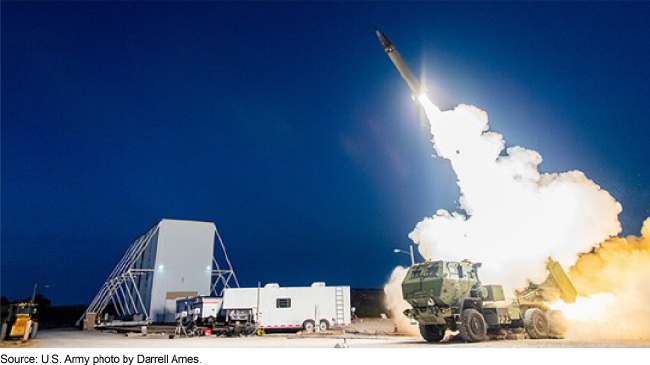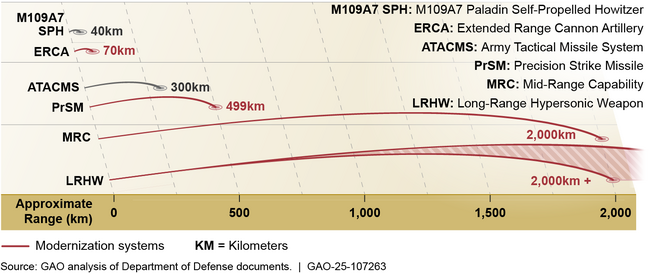Army Modernization: Leading Practices Could Better Support Delivery of Artillery and Missiles
Fast Facts
The Army is shifting focus from fighting insurgencies in the Middle East to preparing for potential large-scale combat operations. This shift means different priorities for its weapon systems—including long-range artillery and missiles.
The Army's success in developing such systems rapidly has been mixed. One of four planned systems was canceled because of testing failures due to technology that wasn't yet ready. Our leading practices for product development call for continually evaluating new technologies and incorporating them into weapons systems only when they have been successfully demonstrated.
Our recommendations to the Army address this.
Precision Strike Missile Production Qualification Test

Highlights
What GAO Found
Since 2018, the Army's focus has shifted from counterinsurgency, particularly in Iraq and Afghanistan, to large-scale combat operations with near-peer adversaries. At that time, the Army began modernizing its major weapon systems, including the missiles and artillery known as long-range fires to counter the capabilities of near-peer adversaries.
The Army identified four capability gaps to support modernization and developed corresponding requirements, such as increased range, for four new or upgraded long-range fires systems: the Extended Range Cannon Artillery, the Precision Strike Missile, the Mid-Range Capability missile system, and the Long-Range Hypersonic Weapon.
Ranges of Existing Systems and Long-Range Fires Modernization Programs

The Army had mixed success in rapidly developing and fielding its long-range fires systems. For instance, after extensive testing, the Army ended one system due to development challenges from immature technologies. For another system, it began production but missed its fielding goal. In contrast, for the other two systems, the Army successfully developed and tested one system, developed a prototype for the other, and it is fielding both.
The Army did not consistently apply leading practices for iterative product development to its long-range fires efforts. For example, with Extended Range Cannon Artillery, the Army did not maintain a sound business case by re-evaluating the technical feasibility of the effort, which contributed to the Army not continuing the program. The Army is currently seeking a self-propelled howitzer to meet this requirement. The Army used a linear (versus iterative) approach for Precision Strike Missile. Adopting an iterative development approach, which includes digital engineering, could shorten development of future increments. Mid-Range Capability used some elements of an iterative approach, including establishing a sound business case with flexible requirements. Implementing other aspects, such as developing a virtual representation of the system, known as a digital twin, could aid future development and production.
Why GAO Did This Study
The Army is modernizing its artillery, rocket, and missile systems to provide long-range fires capabilities to counter advances by potential adversaries. With the Army's shift in focus from counterinsurgency to large-scale combat operations, it urgently needs artillery and missile systems that are more mobile, survivable, and lethal than existing systems.
A House report and Senate report include provisions for GAO to review the Army's long-range fires modernization efforts. This report (1) describes capability gaps identified by the Army, (2) examines Army's progress in developing modernized systems for long-range fires, and (3) assesses the extent to which the Army applied leading practices for iterative product development in these efforts.
GAO reviewed requirements documents, acquisition approaches and plans, schedules and program status updates, and budget requests. GAO conducted site visits to Army requirements and acquisition offices at Fort Sill in Oklahoma and Redstone Arsenal in Alabama. GAO compared acquisition plans and progress against leading practices for iterative product development.
Recommendations
GAO is making three recommendations related to Army's adoption of leading practices for three systems. GAO previously made a recommendation on iterative development for Long-Range Hypersonic Weapon. The Department of Defense concurred with the recommendations.
Recommendations for Executive Action
| Agency Affected | Recommendation | Status |
|---|---|---|
| Department of the Army | The Secretary of the Army should ensure that new efforts to meet requirements for a self-propelled howitzer capable of long-range fires incorporate leading practices for iterative product development, such as continuous evaluation of the business case, including the assessment of technology maturation. (Recommendation 1) |
When we confirm what actions the agency has taken in response to this recommendation, we will provide updated information.
|
| Department of the Army | The Secretary of the Army should ensure that the Precision Strike Missile (PrSM) program assesses the practicality, benefits, and affordability of implementing an iterative product development approach that includes digital engineering tools, such as digital threads and digital twinning, for missile development. (Recommendation 2) |
When we confirm what actions the agency has taken in response to this recommendation, we will provide updated information.
|
| Department of the Army | The Secretary of the Army should ensure that the Mid-Range Capability (MRC) program's planned assessment of the practicality, benefits, and affordability of implementing digital engineering includes consideration of the use of digital threads and digital twinning, and whether to incorporate these tools into the program. (Recommendation 3) |
When we confirm what actions the agency has taken in response to this recommendation, we will provide updated information.
|
